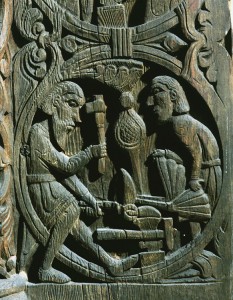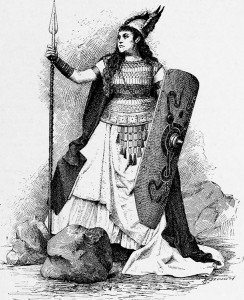Mythic Monday: Almost Indestructible Siegfried
Monday, November 20th, 2017November 20, 2017
Often the most intriguing element of a hero’s story is his or her vulnerability. The ancient Greek hero Achilles had his heel, and the medieval German literary hero Siegfried had that little spot between the shoulder blades, you know, where scratching an itch can be difficult to reach. Both legendary warriors could have thwarted death had they not had an almost-avoided weak spot.

Sigurd the Dragon Slayer of Teutonic mythology was the model for Siegfried the medieval hero in German literature. Sigurd watches the bearded blacksmith Regin make a sword for him.
Credit: Detail of a wood panel (1100′s) from Setsdale Church, Oldsaksammlung, Oslo, Norway (photo © Dagli Orti, The Art Archive)
Achilles’s mother held the back of his foot as she dipped him in the River Styx of the underworld. The river’s water made those who bathed in it invulnerable. Achilles met his end when a poisoned arrow struck him in his, um, Achilles heel, the only spot that was not washed in the Styx.
Siegfried—hero of the Germanic epic poem the Nibelungenlied, written about A.D. 1200—also had a fatal flaw. The character of Siegfried was based on Sigurd the Volsung, a hero in the Icelandic Völsunga Saga, written around the same time. As the story goes, the young Siegfried obtained the massive treasure hoard of the Nibelungs. (Harry Potter readers might be interested that the treasure included an invisibility cloak.) Siegfried killed a dragon and bathed in its magical blood, making him invulnerable—except one specific spot. A leaf of a linden tree, it seems, had fallen on our hero’s back as he bathed, leaving a couple inches unprotected.
Siegfried would later help the Burgundian people—who lived along the Rhine River—defeat their enemies in battle. He wished to marry Kriemhild, a beautiful Burgundian princess. Siegfried agreed to help Kriemhild’s brother, King Gunther, woo the physically strong Valkyrie, Queen Brunhilde of Iceland. Gunther, aided by Siegfried’s trickery involving his magical cloak, succeeded, so the king and princess married their sweethearts in a double marriage ceremony. Brunhilde later found out about the trick and made Siegfried her enemy. Her ally, Hagen, discovered Siegfried’s leaf-shaped weakness and fatally speared him through the back. The story of the Nibelungenlied—a tale of bloodshed, revenge, treasure theft, and bathing advice—would go on, but sadly without its nearly unbreakable hero.



